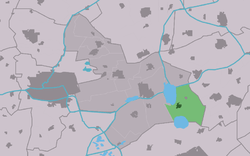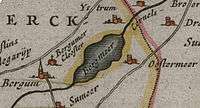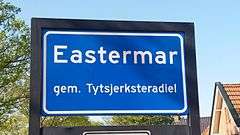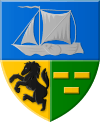Eastermar
| Eastermar Oostermeer | ||
|---|---|---|
| Village | ||
|
Eastermar marina | ||
| ||
 Location of the village in Tytsjerksteradiel | ||
 Eastermar Location in the Netherlands | ||
| Coordinates: Coordinates: 53°10′29″N 6°3′31″E / 53.17472°N 6.05861°E | ||
| Country |
| |
| Province |
| |
| Municipality |
| |
| Population (1 January 2017) | ||
| • Total | 1,575 | |
| Time zone | UTC+1 (CET) | |
| • Summer (DST) | UTC+2 (CEST) | |
| Postal code | 9261 | |
| Dialing code | 0512 | |
Eastermar (Dutch: Oostermeer) is a village in Tytsjerksteradiel municipality in the province Friesland (Fryslân in West Frisian) of the Netherlands. It had around 1,575 citizens in January 2017.[1]
History

As early as 4000 BC there were nomads in this area. An important archaeological discovery was made at Burgumer Mar, a lake to the northwest of Eastermar. This discovery is known as the Leien-Warten Kompleks. Also found around Eastermar were mammoth teeth and gold rings, now in the Regional Museum in Burgum.
The first farmers settled on the higher grounds east of the Burgumer Mar. Around 1200, the first stone church was built here, which was later known as the Protestant church of Eastermar. The community is believed to be several centuries older than the church. As shown on a 1605 map, originally the name Eastermar referred to this community, now It Heechsân, a hamlet to the east of today's Eastermar. In the Middle Ages there were already several farms around the church and to the north and south of It Heechsân.
This 1605 map shows the ancient Burgumer Mar to the northwest of the village, but not yet De Leien, the lake to the south that came into being during the large-scale peat extraction that took place between 1500 and 1750.
During this period, peat workers built a hamlet at the crossing point between a road and a waterway (Lits). This settlement, called De Wâl, was a place of shipping, trade and craft and became the main centre in this area, eventually surpassing the older hamlet and assuming its name, Eastermar.
After 1750, farming became dominant again in this area, and still is.
Community

Population
- 1954 - 1415
- 1959 - 1318
- 1964 - 1297
- 1969 - 1265
- 1973 - 1222
- 2006 - 1564
Famous (former) residents of Eastermar
- Doutzen Kroes (January 23, 1985) - Model
Notable buildings
References
- ↑ Overzicht inwonersaantal Tytsjerksteradiel - Tytsjerksteradiel

